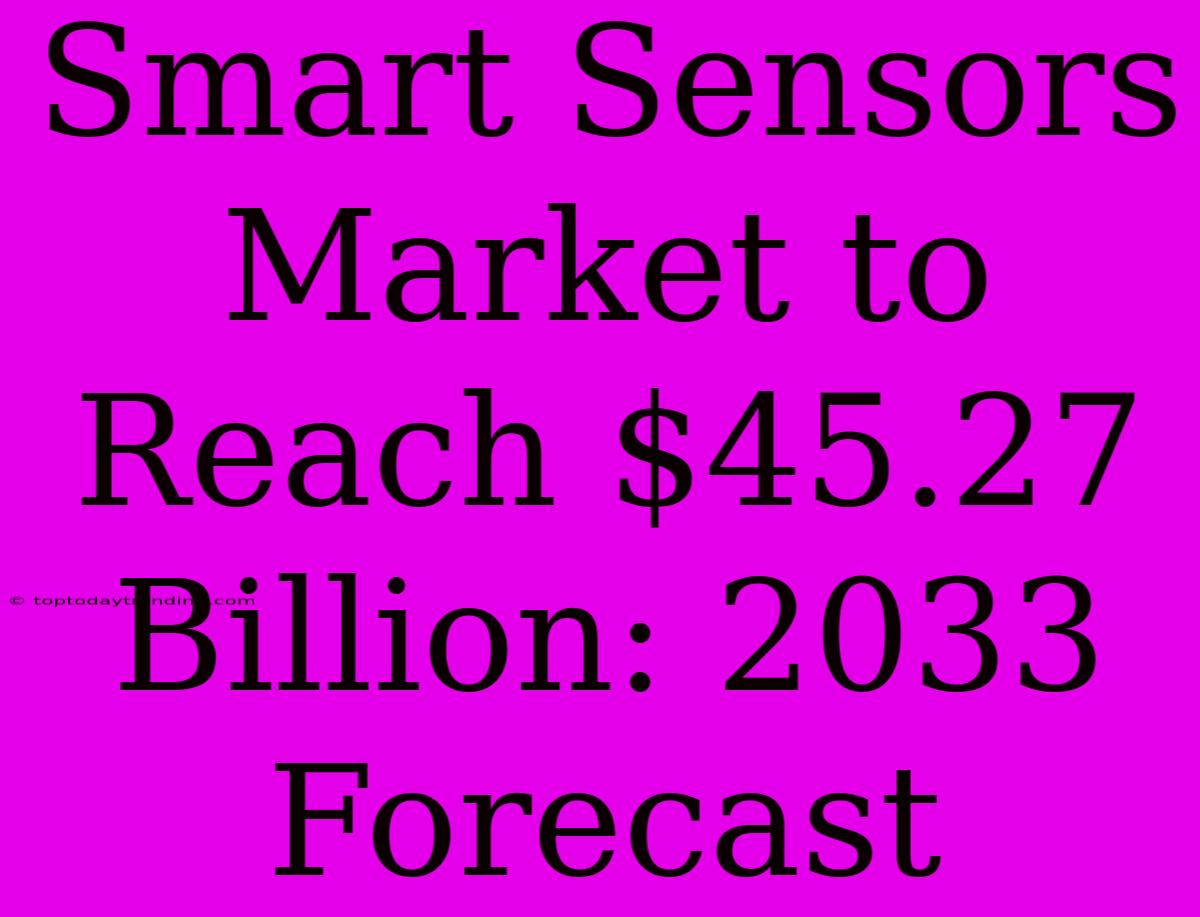Smart Sensors Market to Reach $45.27 Billion: 2033 Forecast
The global smart sensors market is projected to reach $45.27 billion by 2033, growing at a CAGR of 12.1% during the forecast period. This growth is being driven by the increasing adoption of smart sensors across various industries, such as manufacturing, healthcare, automotive, and agriculture.
Key Drivers of Smart Sensors Market Growth
1. Growing Demand for Automation and IoT Solutions:
Smart sensors are an essential component of automation and IoT solutions, enabling devices to collect and analyze data in real-time. As industries strive to optimize operations, improve efficiency, and reduce costs, the demand for smart sensors is on the rise.
2. Advancements in Sensor Technology:
The development of advanced sensor technologies, including MEMS, CMOS, and nanotechnology-based sensors, is contributing to the growth of the market. These sensors offer improved accuracy, sensitivity, and reliability, making them ideal for demanding applications.
3. Rising Adoption in Automotive and Industrial Applications:
The automotive and industrial sectors are witnessing significant adoption of smart sensors for applications such as autonomous driving, predictive maintenance, and process optimization.
4. Increasing Government Investments in Smart Cities and Infrastructure:
Governments around the world are investing heavily in smart cities and infrastructure projects, which require smart sensors for traffic management, environmental monitoring, and public safety.
5. Growth of the Healthcare Sector:
Smart sensors are playing a crucial role in the healthcare sector for wearable health monitoring devices, remote patient monitoring, and diagnostics.
6. Technological Convergence and Integration:
The convergence of smart sensors with other technologies, such as cloud computing, big data analytics, and artificial intelligence (AI), is opening up new opportunities for innovation and growth.
Market Segmentation
The smart sensors market can be segmented based on:
By Type:
- Temperature Sensors: Widely used in industrial processes, HVAC systems, and automotive applications.
- Pressure Sensors: Important for measuring pressure in various applications, including medical devices, industrial automation, and aerospace.
- Motion Sensors: Used in security systems, robotics, and automotive applications for detecting movement and position.
- Optical Sensors: Employed in imaging, lighting, and industrial automation for detecting light, color, and distance.
- Other Sensors: Includes various other sensor types such as gas sensors, humidity sensors, and chemical sensors.
By Application:
- Automotive: Includes applications such as ADAS, engine management systems, and vehicle safety systems.
- Industrial: Used for process control, automation, and predictive maintenance.
- Consumer Electronics: Found in smartphones, wearables, and smart home devices.
- Healthcare: Utilized for patient monitoring, diagnostics, and medical devices.
- Aerospace & Defense: Employed in aircraft systems, satellite communication, and military applications.
- Agriculture: Used for precision farming, environmental monitoring, and livestock management.
- Others: Includes applications in building automation, energy management, and security systems.
Key Players in the Smart Sensors Market
The smart sensors market is highly competitive with several prominent players including:
- Texas Instruments
- Analog Devices
- Bosch Sensortec
- STMicroelectronics
- Honeywell
- NXP Semiconductors
- Infineon Technologies
- Sensata Technologies
- TE Connectivity
These players are actively investing in research and development, partnerships, and acquisitions to enhance their product offerings and expand their market share.
Future Outlook
The smart sensors market is expected to continue its strong growth trajectory in the coming years, driven by increasing adoption across various sectors. The development of next-generation sensor technologies, such as artificial intelligence (AI)-powered sensors, will further fuel market growth.
Key Trends Shaping the Future of Smart Sensors:
- Miniaturization and Integration: Sensors are becoming smaller and more integrated with other components, making them ideal for wearables and other compact devices.
- Wireless Connectivity: The adoption of wireless technologies, such as Bluetooth and Wi-Fi, is enabling sensors to communicate seamlessly with other devices.
- Cloud Integration and Data Analytics: Smart sensors are increasingly being connected to cloud platforms for data storage and analysis, enabling real-time insights and predictive maintenance.
- AI and Machine Learning: AI-powered sensors are becoming increasingly sophisticated, capable of learning and adapting to changing environments.
Conclusion:
The global smart sensors market is poised for significant growth in the coming years, driven by factors such as increasing automation, technological advancements, and rising demand across various industries. The adoption of smart sensors is transforming industries and opening up new possibilities for innovation and efficiency. As sensor technologies continue to evolve, the market is expected to witness even more rapid growth in the years to come.

